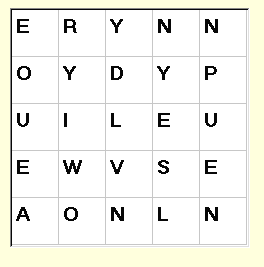What's New - May, 2005
[Home]
May 29. 2005: Another viewer, from Sweden this time, pointed out that there was a date format problem in our Astronomy Demo program. Sure enough, in computing Lunar eclipse dates, I tried to get the January 1st date for the current year to internal date format by converting '1/1/2005'. That works fine if your system expects dd/mm/yyyy or even mm/dd/yyyy date formats. Sweden's date format is yyyy-mm-dd which made the StringToDate function complain that 2005 wasn't a valid day of month. It's fixed now so Sweden can start having Lunar eclipses again!
May 28, 2005: It didn't take long to for the new Convert Decimals to Fractions program to earn its first update. Regular reviewer/contributor Don Rowlett pointed out that I had once again ignored the fact that Europeans use comma (,) instead of dot (.) as a decimal separator. I told him that's the real reason the USA wants to take over the world. Not for freedom, democracy, or even oil. We really just want everyone else to use our decimal point and date formats! But I did fix the program for now to use Windows "decimal separator" character so it should work where ever. Don also knew of a trick for converting repeating decimals to fractional representation, so the user can now specify whether the input decimal terminates or represents one cycle of a repeating decimal.
May 25, 2005: A couple of minor bugs fixed today - The UBigIntsV2 Big Integers unit in DFFLibV02 library file had an error in the modulo routine for 64 bit integers. I also made the second operand independent of the first operand in Add operations so that X.Add(X) now works.
In our Reaction Times application, the Density Plot program required that Delphi 5 be installed in order for the executable to run. That is no longer the case.
May 22, 2005: Here's a program to Convert Decimals to Fractions requested by a viewer a couple of weeks ago. At the time I gave him a few hints but I assume that the homework assignment is past due by now so I can safely post my solution to the problem.
May 10, 2005:
 I ran across this problem in my early Father's Day gift this
year: "The maximum number of individual
regions formed by three lines dividing a circle is seven.
The circle contains an ant colony and each region uniquely contains
between one and seven ants. Can you place seven groups of
ants in the seven regions so that for each of the lines, the total
number of ants on either side are all the same? How many
solutions can you find?". This is from Ivan
Moscovich's latest puzzle book Leonardo's
Mirror & Other Puzzles - geometrical
puzzles with lots of color and good graphics. I was going to
write a program to solve the "ant" puzzle, when I
realized that our Brute Force
program could handle it. So "Ant-ics.prb"
problem is now included with the downloads. I also
added the ability to include images with puzzle descriptions to
help clarify the equations used.
I ran across this problem in my early Father's Day gift this
year: "The maximum number of individual
regions formed by three lines dividing a circle is seven.
The circle contains an ant colony and each region uniquely contains
between one and seven ants. Can you place seven groups of
ants in the seven regions so that for each of the lines, the total
number of ants on either side are all the same? How many
solutions can you find?". This is from Ivan
Moscovich's latest puzzle book Leonardo's
Mirror & Other Puzzles - geometrical
puzzles with lots of color and good graphics. I was going to
write a program to solve the "ant" puzzle, when I
realized that our Brute Force
program could handle it. So "Ant-ics.prb"
problem is now included with the downloads. I also
added the ability to include images with puzzle descriptions to
help clarify the equations used.
May 6, 2005:
 |
|
Medium difficulty
level: |
Akerue is a word search game originally posted several years ago. Find as many words as you can from the letter grid and the program will show you those that you missed. Finding more than half is a challenging task. Here's the first update which includes improved word selection and better level of play (limiting the program to smaller dictionaries for easier levels). Why Akerue? Try reading it backwards.
May 4, 2005: Here is my version of Buffon's Needles, is a classic problem which describes a way to estimate Pi by dropping needles on a grid of parallel lines and counting what fraction cross a line. .
